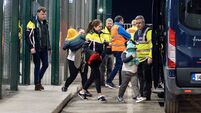One in six students living in areas with poor broadband

Poor broadband issues had led to a call for higher education providers to prioritise access to campus facilities
A new study has found one in six students live in areas with poor broadband coverage, leading to calls for higher education providers to prioritise access to campus facilities for those with substandard internet access.
The paper, published in the International Journal of Educational Technology in Higher Education, looked at students' living spaces based on the address of permanent residence for three of the five years prior to initial enrolment.
HEIs include universities, technological universities (TUs), institutes of technology (ITs), and colleges of education (CEs), as well as a small number of other public and private colleges.
The researchers used enrolment data for the 2017/18 academic year when there were 223,743 enrolments at Irish HEIs.
It also used the An Post GeoDirectory, a database of all residential and commercial buildings in Ireland, and then looked at broadband coverage levels in the context of the Covid-19 pandemic, when campuses and classrooms closed and domestic broadband was being used for work, study, and entertainment, often at the same time.
While a €15m funding package was announced to help with online learning to assist students from lower incomes access laptops, tablets, and internet connectivity, "the majority of this funding was earmarked for laptop purchases and with little detail on the connectivity issues that it may help address".
Regarding broadband access, it said the rural/urban divide was clear and when it came to 3G and 4G coverage, "the quality and stability of this coverage can vary widely, particularly in rural areas where coverage can be extremely poor".
"Overall, of the 167,576 students in the data, 16,462 (9.8%) had domiciles in electoral divisions (EDs) with low broadband coverage, 6008 (3.6%) in very low coverage EDs, 2801 (1.7%) in minimal coverage EDs, and 2,598 (1.6%) in EDs with no high-speed broadband coverage. Overall this implies that 16.6% of students (27,869) in the data were at risk of poor broadband access during the COVID-19 lockdown, assuming a 50% ED coverage threshold.
"It shows that undergraduate and full-time students are more likely to face broadband access issues relative to postgraduate and part-time students respectively."
It also found lower levels of ownership as broadband coverage decreases, and that electoral divisions with the poorest broadband coverage tend to be the most deprived and have the lowest median household income.
"An important implication of the findings is that some HEIs may have to significantly adjust their online delivery methods due to the considerable technological constraints that many students face," it said.
"In addition, the findings also imply that different groups of students within each HEI may require different offerings, or have different capabilities to access blended/online content."
The authors — from the JE Cairnes School of Business & Economics at NUIG, the Department of Economics at UL, and TCD — said: "HEIs could prioritise access to campus facilities for those from areas with poor coverage that are living at home to help ensure an effective and equal learning experience for all students. This could also possibly extend to offering subsidised on-campus accommodation for disconnected students from lower income backgrounds."









